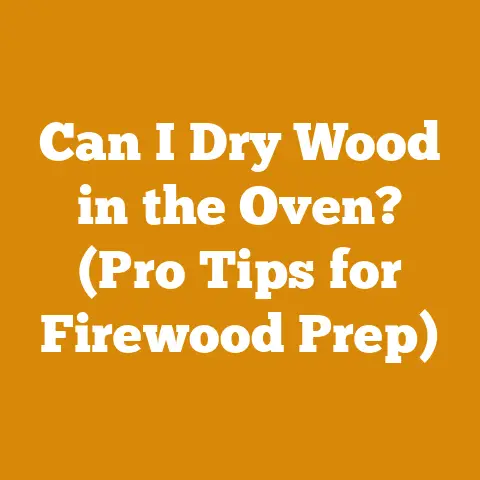Wood Stove Temperature Guide (5 Pro Tips for Optimal Burning)
Are you struggling to get the most heat and efficiency out of your wood stove? Do you find yourself constantly adjusting the damper, unsure if you’re burning too hot or too cold? It’s a common problem. Many people rely on guesswork when managing their wood stove, leading to wasted fuel, excessive smoke, and even potential safety hazards. I’ve seen it countless times – a perfectly good wood stove underperforming because the operator lacks a clear understanding of optimal burning temperatures.
Over the years, I’ve spent countless hours working with wood stoves, from my early days splitting firewood with a maul to now managing timber harvests and advising clients on efficient heating solutions. Through trial and error, and a healthy dose of physics, I’ve developed a system for achieving consistent, efficient, and safe burns in wood stoves. In this guide, I’ll share my top 5 pro tips for understanding and controlling your wood stove’s temperature, helping you maximize heat output, minimize emissions, and enjoy a safer, more comfortable heating experience.
Wood Stove Temperature Guide: 5 Pro Tips for Optimal Burning
1. Understanding Wood Stove Temperature Zones
Before diving into the tips, it’s crucial to understand the different temperature zones within your wood stove and what they signify. I often explain this to clients as analogous to driving a car – you need to know what the gauges are telling you to drive safely and efficiently.
- Cold (<250°F / 121°C): This is the danger zone. At these temperatures, wood doesn’t burn efficiently. Instead, it smolders, producing creosote-laden smoke. Creosote is a highly flammable byproduct that can accumulate in your chimney and cause a chimney fire. I’ve seen the aftermath of chimney fires firsthand, and trust me, it’s not something you want to experience. You’ll also get very little heat output at this temperature.
- Low (250-400°F / 121-204°C): This range is still inefficient and produces excessive smoke. While not as dangerous as the cold zone, prolonged burning at these temperatures will still lead to creosote buildup. You’ll get some heat, but it will be short-lived and require frequent refueling.
- Optimal (400-700°F / 204-371°C): This is the sweet spot. At these temperatures, wood burns cleanly and efficiently, producing maximum heat output with minimal smoke and creosote. This is where you want to spend the majority of your burn cycle. I aim for this range whenever I’m heating my own home.
- High (700-900°F / 371-482°C): This is the warning zone. While you’ll get a lot of heat, burning at these temperatures for extended periods can damage your stove and chimney. It also wastes fuel. Think of it like redlining your car’s engine – it’s fine for short bursts, but not sustainable.
- Excessive (>900°F / 482°C): This is the danger zone. Burning at these temperatures is unsafe and can lead to stove damage, chimney fires, or even house fires. Immediate action is required to reduce the temperature. I’ve seen stoves warped and cracked from overheating, and it’s an expensive and dangerous situation to rectify.
How to Measure Temperature:
- Magnetic Thermometer: The most common and affordable option. It attaches directly to the stovepipe or stove surface. I recommend placing it about 18 inches above the stove on the stovepipe for the most accurate reading.
- Infrared Thermometer: More expensive but provides instant temperature readings. Simply point the thermometer at the stove surface for a quick and accurate measurement.
- Built-in Thermometer: Some newer stoves come with built-in thermometers. These are generally reliable, but it’s still a good idea to double-check their accuracy with a magnetic thermometer.
2. The Wood You Burn Matters: Seasoning and Species
The type and condition of your wood have a dramatic impact on your wood stove’s temperature and efficiency. I can’t stress this enough – burning properly seasoned wood is the single most important factor in achieving optimal burning temperatures.
Seasoning Wood:
- What is Seasoning? Seasoning is the process of drying wood to reduce its moisture content. Green wood, freshly cut wood, can contain up to 50% moisture. Seasoned wood should have a moisture content of 20% or less.
- Why Season? Burning green wood is like trying to burn a waterlogged sponge. The energy is spent boiling off the water instead of producing heat. This results in low temperatures, excessive smoke, and creosote buildup.
- How to Season: The best way to season wood is to split it, stack it loosely in a sunny, windy location, and let it dry for at least six months, preferably a year or more. I always tell people to think of it as an investment – the longer you season, the better the burn.
- Splitting: Splitting increases the surface area exposed to air, speeding up the drying process. I use a hydraulic log splitter for larger rounds, but a good maul works just fine for smaller pieces.
- Stacking: Stack wood in rows with gaps between the rows to allow for air circulation. Elevate the wood off the ground using pallets or scrap wood to prevent moisture from wicking up from the ground.
- Location: Choose a sunny, windy location to maximize evaporation.
- Testing Moisture Content: A moisture meter is an invaluable tool for determining if your wood is properly seasoned. Insert the probes into a freshly split piece of wood. The reading should be below 20%. I use a General Tools MMD4E Digital Moisture Meter. It’s relatively inexpensive and accurate enough for firewood preparation.
Wood Species:
Different wood species have different densities and energy content. Hardwoods generally burn hotter and longer than softwoods.
- Hardwoods: Oak, maple, ash, birch, and beech are excellent choices for firewood. They are dense, burn slowly, and produce a lot of heat. Oak is my personal favorite, but it takes longer to season than other hardwoods.
- BTU Content: Oak (27.5 million BTU per cord), Maple (24 million BTU per cord), Ash (24 million BTU per cord)
- Softwoods: Pine, fir, spruce, and cedar are less dense and burn faster than hardwoods. They are suitable for kindling or starting fires but are not ideal for sustained burns. They also tend to produce more smoke and creosote.
- BTU Content: Pine (18 million BTU per cord), Fir (20 million BTU per cord), Spruce (17 million BTU per cord)
Case Study: Seasoning Wood for Optimal Burning
I once worked with a client who was constantly complaining about his wood stove’s poor performance. He was burning freshly cut pine, straight from his property. The stove smoked excessively, produced very little heat, and required constant refueling. I convinced him to invest in a moisture meter and start seasoning his wood properly.
We spent a weekend splitting and stacking a large pile of oak. He was initially skeptical, but after a year of seasoning, the difference was night and day. The oak burned cleanly and efficiently, producing significantly more heat and requiring far less refueling. He was amazed by the transformation and became a firm believer in the importance of seasoned wood.
3. Air Control: Mastering the Damper
The damper is your primary tool for controlling the airflow to the fire, which directly affects the burning temperature. Understanding how to adjust the damper is crucial for achieving optimal burning temperatures.
- How the Damper Works: The damper controls the amount of air that enters the firebox. More air means a hotter fire, while less air means a cooler fire.
- Starting a Fire: When starting a fire, open the damper fully to provide ample air for the initial combustion.
- Maintaining Temperature: Once the fire is established, gradually close the damper to reduce the airflow and maintain the desired temperature.
- Adjusting for Wood Type: Hardwoods require less air than softwoods. Adjust the damper accordingly.
- Reading the Smoke: The color of the smoke is a good indicator of combustion efficiency. Clear or light gray smoke indicates efficient burning, while dark or black smoke indicates incomplete combustion and the need for more air.
- Overnight Burns: For overnight burns, close the damper almost completely to slow down the burning process and maintain a low, smoldering fire. However, be careful not to close it too much, as this can lead to creosote buildup. I usually leave it cracked open just enough to maintain a small flame.
- Safety Note: Never completely close the damper while the fire is burning. This can lead to carbon monoxide poisoning.
My Experience with Damper Control:
I remember a time when I was struggling to maintain a consistent temperature in my wood stove. I was constantly adjusting the damper, but the temperature would fluctuate wildly. After some experimentation, I realized that the problem wasn’t the damper itself, but the way I was loading the wood.
I started experimenting with different loading patterns, and I discovered that a tightly packed load of wood burned more slowly and consistently than a loosely packed load. This allowed me to fine-tune the damper setting and maintain a more stable temperature.
4. Loading Techniques: Building the Perfect Fire
The way you load wood into your stove can significantly impact its burning characteristics. Different loading techniques are suitable for different situations.
- Top-Down Burning: This method involves placing kindling and small pieces of wood on top of larger pieces of wood. It’s a clean-burning method that produces less smoke and creosote. I often use this method when starting a fire after cleaning the stove.
- Benefits: Cleaner burning, less smoke, easier to control.
- Drawbacks: Requires more preparation, may not be suitable for all stoves.
- Conventional Loading: This method involves placing kindling and small pieces of wood at the bottom of the firebox and larger pieces of wood on top. It’s a more traditional method that’s easy to implement.
- Benefits: Simple and easy, works well in most stoves.
- Drawbacks: Produces more smoke, can be harder to control.
- Parallel Loading: This method involves loading the wood parallel to the door, creating a long, narrow firebox. This is a good option for stoves with a narrow firebox. It allows for more even burning across the wood’s length.
- Benefits: Good for narrow fireboxes, allows for even burning.
- Drawbacks: Requires careful arrangement of wood.
- Criss-Cross Loading: This method involves layering wood in a criss-cross pattern. This promotes good airflow and even burning. I use this method frequently for longer burns, as it allows for sustained heat output.
- Benefits: Promotes good airflow, even burning.
- Drawbacks: Can be time-consuming to arrange.
Factors to Consider When Loading:
- Wood Size: Use a variety of wood sizes, from small kindling to larger pieces.
- Airflow: Leave space between the pieces of wood to allow for good airflow.
- Stove Size: Don’t overload the stove. Leave enough space for the fire to breathe.
- Wood Species: Hardwoods can be loaded more densely than softwoods.
Original Insight: The Importance of “Hot Starts”
One thing I’ve learned over the years is the importance of a “hot start.” This means getting the fire burning hot and quickly before adding larger pieces of wood. A hot start helps to ensure that the wood ignites quickly and burns cleanly. I achieve this by using plenty of kindling and small pieces of wood, and by opening the damper fully.
5. Chimney Maintenance: Preventing Creosote Buildup
Creosote is a flammable byproduct of incomplete combustion that can accumulate in your chimney. Regular chimney inspections and cleaning are essential for preventing chimney fires. This is arguably the most important aspect of safe wood stove operation, and I urge everyone to take it seriously.
- What is Creosote? Creosote is a tar-like substance that forms when wood smoke condenses in the chimney. It is highly flammable and can ignite if it accumulates in sufficient quantities.
- Causes of Creosote Buildup:
- Burning green wood
- Burning softwoods
- Low burning temperatures
- Restricted airflow
- Signs of Creosote Buildup:
- Dark, oily deposits on the chimney cap
- A strong, smoky odor
- Reduced draft
- A chimney fire
- Chimney Inspection: Inspect your chimney regularly, at least once a year, preferably twice. I recommend hiring a professional chimney sweep for a thorough inspection.
- Chimney Cleaning: Clean your chimney whenever you notice signs of creosote buildup. You can hire a professional chimney sweep or clean it yourself using a chimney cleaning brush.
- Preventing Creosote Buildup:
- Burn only seasoned wood
- Burn hardwoods whenever possible
- Maintain optimal burning temperatures
- Ensure adequate airflow
- Have your chimney inspected and cleaned regularly
Case Study: The Importance of Chimney Cleaning
I once had a friend who ignored the signs of creosote buildup in his chimney. He continued to burn wood without having his chimney inspected or cleaned. One cold winter night, he woke up to the sound of a roaring fire in his chimney. He was lucky to escape with his life, but his house was severely damaged.
This experience taught me the importance of regular chimney maintenance. I now make it a point to inspect and clean my chimney at least twice a year, and I encourage everyone to do the same.
Tools for Chimney Maintenance:
- Chimney Cleaning Brush: A wire brush used to scrub creosote from the chimney walls. I recommend a brush that is the same size and shape as your chimney flue.
- Chimney Sweep Rods: Flexible rods used to extend the reach of the chimney cleaning brush.
- Chimney Inspection Camera: A camera used to inspect the inside of the chimney for creosote buildup and other problems.
Strategic Insights for Long-Term Wood Stove Efficiency
Beyond the immediate tips for controlling temperature, consider these strategic insights for long-term wood stove efficiency and safety:
- Invest in a High-Efficiency Wood Stove: Newer wood stoves are designed to burn more cleanly and efficiently than older models. They often feature advanced combustion technology that reduces emissions and maximizes heat output. This is a significant upfront investment, but it can pay off in the long run through reduced fuel consumption and lower maintenance costs.
- Properly Insulate Your Home: A well-insulated home will require less heat to maintain a comfortable temperature. This will reduce the amount of wood you need to burn and extend the life of your wood stove.
- Consider a Wood Furnace: If you are heating a large home, a wood furnace may be a more efficient option than a wood stove. Wood furnaces are designed to heat an entire house using a central heating system.
- Participate in Wood Stove Change-Out Programs: Many government agencies and non-profit organizations offer programs to help homeowners replace old, inefficient wood stoves with newer, cleaner-burning models.
Final Thoughts and Next Steps
Mastering your wood stove’s temperature is a journey, not a destination. It requires practice, patience, and a willingness to experiment. By understanding the principles outlined in this guide and applying them to your own situation, you can achieve optimal burning temperatures, maximize heat output, minimize emissions, and enjoy a safer, more comfortable heating experience.
Here are some practical next steps you can take:
- Assess Your Wood Supply: Determine the moisture content of your wood and start seasoning more wood if necessary.
- Inspect Your Chimney: Check for signs of creosote buildup and schedule a cleaning if needed.
- Experiment with Loading Techniques: Try different loading methods to see which works best for your stove and wood type.
- Monitor Your Stove Temperature: Use a thermometer to track your stove’s temperature and adjust the damper accordingly.
- Keep Learning: Stay informed about the latest wood stove technology and best practices.
Remember, safety is paramount. Always follow the manufacturer’s instructions for your wood stove and chimney, and never hesitate to consult with a professional if you have any questions or concerns. Happy burning!






